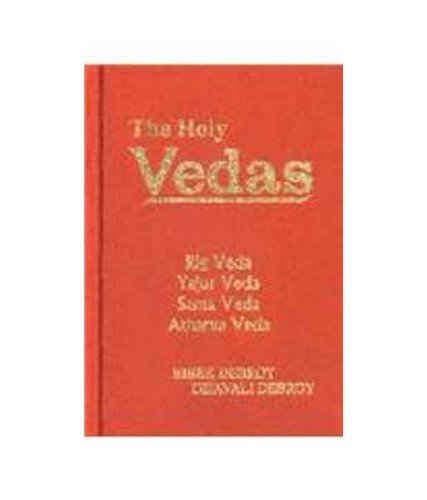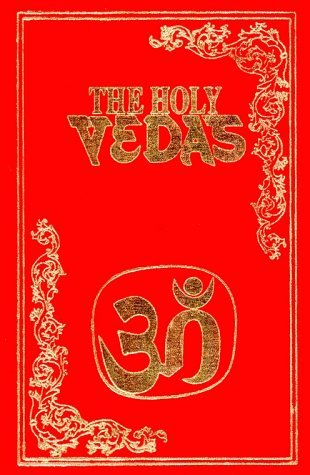Definition of Vedas


Let’s have a look at what the vedas are all about and mean?. The Vedas, are a form of knowledge. It is also an eternal scripture and essential reference point for all forms of Hinduism. It is a direct revelation to Hindu prophets. Which is then spread for generations until they were written down.
Where did the Vedas come from?
Vedic religion, also called Vedism. It is the religion of the ancient Indo-European-speaking people. They entered India about 1500 bce from the region of present-day Iran. It takes its name from the collections of sacred texts
known as the Vedas.
A brief look into the the four Vedas
The Vedas are considered the oldest Hindu texts. Scholars believe that they were written down some 2,500 years ago. Although the tradition often dates them to the beginning of Kali-yuga (3000 BCE).
Some Hindus say that there was originally only one Veda, the Yajurveda. This was later divided into four.Scholars, however, usually consider the Rig-Veda the oldest of all Hindu writings. The following is an overview of the four Vedas.

The Rig Veda
The Rig Vedas are the oldest texts of the Indian civilization dating back to the Aryans. A collection of Vedic hymns, they are a collection of 1,028 hymns and 10,600 verses. The Rig Veda originated around 1600 BCE. The written manuscripts of the Rig Veda belong to one millennium BCE. But its existence point in some others states it to be somewhere between the 11th and 14th centuries
The Rig Veda is of four text types
The Samhitas (hymns) singing the praises of the Rig Veda deities. These include Indra – King of Devas, Agni-God of Fire, and Ishwara the Supreme God. Soma- a sacred portion of the plant used as offering in Vedic sacrifices.
The Aranyakas – the philosophy behind the rituals. Upasanas – one that focuses on worship.
The Rig Veda has ten Mandalas. It begins with praising the Supreme Being. Besides that it goes on to agriculture, cattle-raising, and horse racing.
The Sama Veda
The Sama Veda is all about melodies and chants, divided into two major parts. The first part comprises of the Saman or four melody collections. The Arcika is the collection of verse book, a group of hymns. Except for 75 verses, all of them originate from the Rig Veda.
The compilation of the Sama Veda occurred around 1200 to 1000 BCE. The period is contemporary to the Atharvaveda and the Yajurveda.The Sama Veda is called the Book of Songs, derived from Saman – Song, and Veda. The Sama Veda is the principal root of traditional Indian music and dancing. It ranks as the oldest in the world. Two of the 108 Upanishads exists in the Sama Veda – the Chandayoga and Kena Upanishad. Sama Veda points to the ancient cultural heritage and is a matter of pride for Hindus.
The Yajur Veda
The Yajur Veda comprises of Yajus and Ved. The meaning prose is dedicated to reverence or religious worship. The Yajur Veda is primarily a book of rituals. The ancient Vedic text has a compilation of procedures for ritual
offerings or prose mantras to be chanted by a priest. At the same time, an individual performs the ritual in front of the Yagna (sacrificial fire). The Yajur Veda dates back to 1200 to 1000 BCE. In contrast it is contemporary to the hymns sung in the Sama Veda and Atharva Veda.
The most ancient is Yajur Veda, the Samhita, comprises of1875 verses. This was built upon the foundation of the Rig Veda. The middle layer includes the Satapatha Brahmana. It consists of the most extensive collection of primary Upanishads. Yajur Veda is again a reminder of India’s ancient cultural heritage. It gives information about agriculture, social and economic life during the Vedic period.
The Atharva Veda
The fourth and final text of the Vedic scriptures, the Atharva Veda. This is the knowledge storehouse of the Atharvanas (formulas) to navigate everyday life. This Veda is more receptive to the culture and tradition of the day. It is not limited to religious and spiritual teachings only. In this regard, it does not connect with the other three Vedas.
It is also called as the Vedas of Magic Formulas.The Atharva Veda is an amalgamation of many elements. Such as hymns, chants, spells that involves healing processes, and longevity of life. The Atharva Veda focuses on the knowledge of attaining God through spiritual practice.The Atharva Veda is a collection of 730 hymns, containing 6,000 mantras. This Veda contains three Upanishads.
The Atharva Veda belongs to the 2nd millennium BC. The Samhitas in this Veda talk about surgical and medical procedures. It contains mantras and verses offering treatment for ailments. The Atharva Veda finds relevance in today’s society. This gives an impression as if it was a forerunner of medicine and healthcare. This book has
optimum use for any Vedic scholar even today.
Interest and looking for similar kind of topics click here What is Religion dharma?


